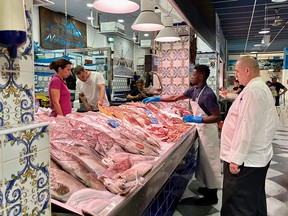Combing the market stalls of Santa Cruz de Tenerife with a Windstar executive chef is a lesson in sourcing local.
Reviews and recommendations are unbiased and products are independently selected. Postmedia may earn an affiliate commission from purchases made through links on this page.
Article content
I love shopping with people who drop cash. It’s just so exciting – and has nothing to do with my bank account. And being a foodie, I jumped at the chance to go to the main food market in Santa Cruz de Tenerife with chef Stefan Vasilev and sous chef Alvyn Guillarte from Windstar Cruises – who were armed with an absolute mittful of money.
I enjoyed a week-long cruise of Spain’s subtropical Canary Islands off the eastern coast of Africa on the 312-passenger Star Pride. The itinerary began in sunny Las Palmas de Gran Canaria with stops at the volcanic island of Lanzarote, the verdant La Gomera, busy Santa Cruz de Tenerife and finally, Portugal’s charming Madeira. The Canary Islands offer varied Spanish and African cultural heritages, geological oddities, cloud forests and perfect beaches. And each port has its own distinct character, as well as its unique cuisine.
Advertisement 2
Article content
“It is always exciting to be at a different place,” said Chef Stefan. “We arrange to have local and seasonal products and produce sent to the ship wherever we dock – fish and fruit and vegetables. Then, we are able to put a ‘fresh local flavours’ sign on the lunch menus. The guests really like this.”
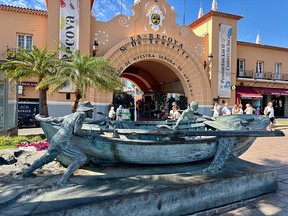
The fact that each port of call has an army of workers loading up visiting cruise ships with whatever they need – incredible Canary Island wine included – doesn’t stop Stefan from wandering out into the streets on a mission to bring new flavours back to the ship. “I always like to go to the local markets myself to see what is fresh and available,” he said.
A few Star Pride passengers and I followed the chefs into Mercado Nuestra Señora de Africa, a vibrant and historic, neocolonial-style market right on the Santa Cruz waterfront. Built in 1943 and affectionately known as La Recova, it is anchored to a Moorish clock tower and features befitting statues out front, including Lechera (the Milkmaid) and a bronze artwork of a fishing boat. A bridge connects the market to Calle del Castillo, Santa Cruz’s main shopping strip.
Article content
Advertisement 3
Article content
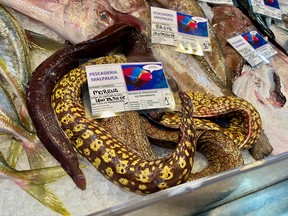
We fell in step with the rhythm of this traditional marketplace, checking out the fruit and vegetable stalls, and those selling local artisanal crafts. But it’s in the market’s basement, where all the fishmongers are stationed, that things get interesting.
Stefan started off by buying out a whole tray of dorado, also called mahi-mahi – several pounds of it. The vendor began with the weighing and packaging right away, which took about five minutes. She was clearly happy to have made such a big sale, but was trying to keep the glee to herself. The box of dorado is enough to feed about 60 people, Stefan said. “We have about 300 guests, so this is standard. If I see something great, I get it, like this dorado. Everything is bought for cooking the same day, so it is all fresh. We don’t freeze anything or what would be the point?”
The fish market slowly started to get busier, with workers loading up their stalls for the day. I saw fish so fresh-looking, it looked like it was made of glass, glistening on its bed of ice – beautiful squids and prawns, the biggest king crab legs I’ve ever seen and so many different kinds of eel. Stefan took out his phone to show us a video of a fishmonger taking just a few seconds to clean an eel. He provided a running commentary as the eel is cleaned, chopped up into portions and scooped into a bag. “Done! We don’t have to do anything, except cook it.”
Advertisement 4
Article content
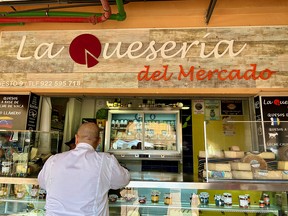
We stopped to buy a big box of sardines for the crew, coated and seasoned and deep-fried. “We buy something for the crew as often as possible,” said Stefan. “They get tired of eating the same things every day just like anyone else.”
The Star Pride kitchens really did outdo themselves on more than a few occasions during my week. Thanks to Windstar’s ties to the James Beard Foundation, its annual awards the height of culinary honours, the menu of the ship’s main restaurant, Amphora, features recommendations for each course chosen by the foundation. The ship also has the indoor-outdoor buffet-style The Veranda for breakfast and lunch, plus three specialty restaurants, including the cozy Spanish-style Cuadro 44. This is where our fresh dorado headlined the menu.
Windstar also offers more involved food excursions on shore, including cooking classes and winery tours. Lanzarote is particularly noted for its wine, with some estates dating back to the 17th century. The food roots on the islands are indeed deep.
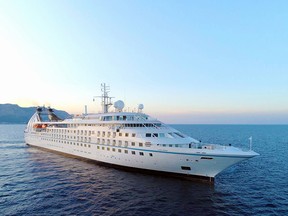
The VIP treatment
Back on the market’s ground floor, we took turns leaning in to taste incredible cheeses that the cheesemonger offered with his knife. We tried a soft cheese, but dismissed it as impractical, because it would just melt on the buffet tables back on board. Stefan found a harder cheese he favoured and out came the big envelope of cash once more, to buy two entire wheels.
Advertisement 5
Article content
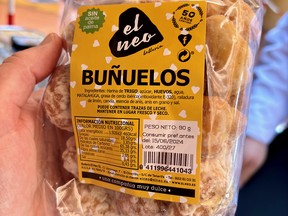
Our total spend for the morning came to about 600 euros, which included several pounds of cream cheese.
All the cheese-tasting made us hungrier, so someone bought a bag of buñuelos, little fried-dough fritters that we devoured in seconds. With the shopping over, we sat down for a mid-morning coffee before returning to the ship. I ordered a Barraquillo, a local confection specific to Tenerife. It’s a layered coffee with condensed milk, espresso, something called Licor 43 (which sounds a bit mysterious), a dash of latte milk and a sprinkle of cinnamon. Really, it is a cocktail, not a coffee. It was barely 10 in the morning, but I was on holiday.
The writer was hosted by Windstar Cruises. No one from the cruise line approved of or vetted this story before publication.
Article content

